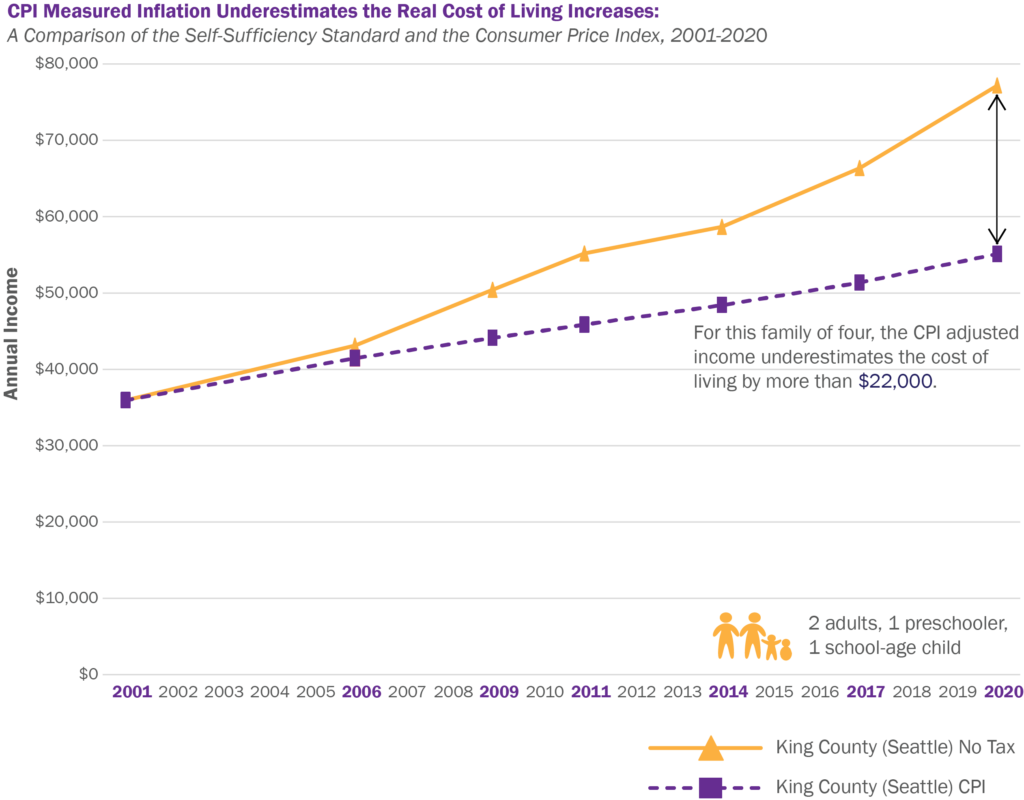Inflation, High Costs, and Making Ends Meet
August 12, 2022
Alyssa Mast | Student Assistant, Center for Women’s Welfare
According to the Bureau of Labor Statistics (BLS), the annual inflation rate was 9.1% in July, the highest its been since 1981.[1] Talk of rising inflation is dominating the news cycles, but what is inflation, what does it mean for families struggling to make ends meet, and how does it compare to the increase in cost of basic needs observed in the Self-Sufficiency Standard?

Inflation is the change in price for a basket of goods over time. It is typically calculated by measuring price data, typically in urban areas, and presented by the BLS as the Consumer Price Index (CPI). A poll by Pew Research showed 70% of Americans view inflation as a “very big problem,” ranking their concern well over the affordability of health care, gun violence, and climate change.[2] President Biden has also named inflation as his “top domestic priority” and highlighted the need to bring down costs.[3]
Inflation measures, however, do not accurately represent “inflation inequality,” or the added burden rising inflation has on low-income families. Not only do price increases impact families with tight budgets more, but inflation is often greater on necessities than luxury goods. While high-income families can typically wait to travel, buy new cars, or renovate their homes (reductions in demand when prices increase can stabilize the market and limit the impacts of inflation), families cannot wait to buy necessities, like food, gas, or housing, forcing them to pay the high prices for items they may already be unable to afford.[4] Moreso, low-income families do not have the time to “shop around,” do extensive research on deals or coupons, or build large stockpiles that could help them through periods of high inflation.[5] Inflation measures are also often the combined effect of a wide variety of goods, from airplane tickets to gas to toothpaste, so the observed changes in the prices of the goods families purchase cannot be assumed by inflation alone. In other words, because many prices are being averaged, inflation underestimates the changes in the price of necessities.
Self-Sufficiency Standard data confirms that changes to the costs of basic needs exceed the changes expected from inflation. In Washington, for example, the wage needed for a single adult in King County (Seattle) in 2020 (when the last full report was produced) was $30,410 without the inclusion of taxes or tax credits.[6] The wage required for a single adult in 2001 was $12,164, so someone living in Seattle experienced a 150% increase over the last twenty years. If the wage from 2001 was adjusted for inflation alone, this single adult would be expected to need just $18,647 in 2020, or a 53% increase.[7] Adjustments for inflation underestimate the costs of living by almost $12,000. This gap is even more profound for families, who have larger budgets and needs. In 2020, a family of 2 adults, 1 preschooler, and 1 school-age child in Seattle would need $77,183 to be self-sufficient (again without taxes or tax credits), a 115% increase since 2001. If calculated based on 53% inflation, this family would be expected to need $53,541, a difference of more than $22,000 and a drastic underestimation of what it takes to make ends meet.

Despite its limitation in determining the financial burden, discussions of inflation expose the fact that people aren’t getting paid enough to survive and wage gaps are continuing to worsen. Since 2001, in Washington state, the median hourly wage for all occupations increased by about 64%. While slightly higher than inflation, this is about half the increase in costs observed in the Standard. There was also wide variation between occupations: social and community service managers, for example, saw an increase of only about 12%; health care support operation workers saw an increase of about 47%; food preparation and server related positions saw a 96% wage increase since 2001; and computer programmers saw more than a 107% increase.[8] In this past year, as demonstrated by Brookings, some frontline workers saw real pay increases of less than 20 cents (meaning the increase after being adjusted for inflation), if they saw any increase in wages at all.[9] For jobs that already pay below the Self-Sufficiency wage, these increases do not keep pace with the increasing cost burden for necessities.
While inflation is often the center of economic discussion, how much does it really matter? Economists argue over how much inflation is too much, how to appropriately address it, and how to help families struggling to get by. The overwhelming focus on inflation, rather than specific costs of basic needs, however, may detract from the burdens faced by low-income families. Several news sources focus on individual economic responsibility, such as reducing expenses and increasing income, to weather this high-cost period. Instead, policies such as the expansion of the Child Tax Credit, universal pre-K, child care coverage in employment packages, expanded funding for housing vouchers, and funding the continuation of health insurance premium tax credits could reduce costs for households, allowing them to be better financially positioned over time, even if their wages stay low and even after inflation returns to a lower level.[10]
The overwhelming focus on inflation, rather than specific costs of basic needs, however, may detract from the burdens faced by low-income families.
Looking at the costs of basic needs, such as those presented in the Standard, shows that costs have been steadily increasing, even while inflation was low in 2001 and the early 2010’s. Additionally, wages have not grown at the same rate and have failed to meet the needs of families across the nation. Addressing income inequality, systemic barriers to achieving self-sufficiency, such as inequitable access to education, housing and hiring discrimination, and racist economic practices, and understanding what costs families are spending most of their income on can also help us understand who inflation is impacting at disproportionate rates. Without raising wages and passing policies that reduce the financial burdens on low-income families, many households will continue to not make enough to meet basic costs of housing, child care, food, and health care, regardless of the level of inflation or the measures taken to address it.
Thank you to Dr. Diana Pearce and Annie Kucklick for providing their expertise to this analysis.
